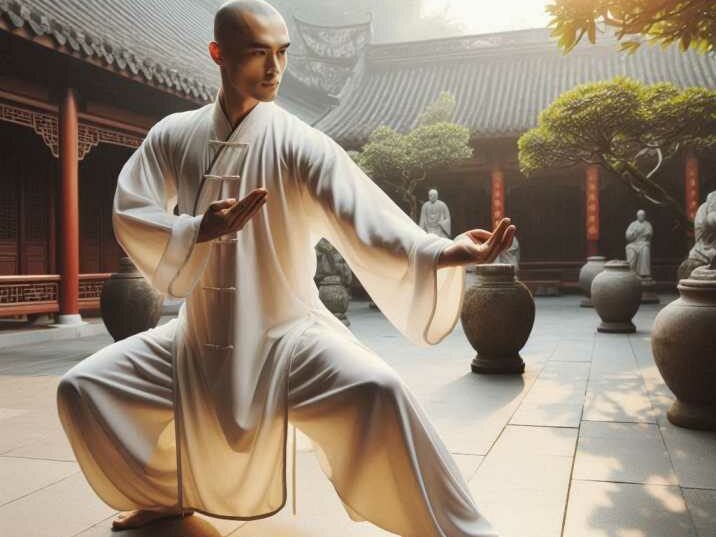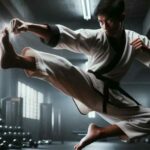Introduction
Table of Contents
Shaolin Kung Fu Qigong is a profound practice that merges the physical discipline of Kung Fu with the internal cultivation of Qigong. Originating from the legendary Shaolin Monastery in China, this ancient art has captivated practitioners worldwide, offering a unique blend of physical strength, mental clarity, and spiritual growth. In this comprehensive guide, we will delve into the rich history, fundamental principles, key techniques, and numerous benefits of Shaolin Kung Fu Qigong. Whether you’re a seasoned martial artist or a curious beginner, this post will provide you with valuable insights into mastering this remarkable practice.

The Origins of Shaolin Kung Fu Qigong
The Birthplace: Shaolin Monastery
The Shaolin Monastery, nestled in the Songshan Mountains of Henan Province, China, is the cradle of Shaolin Kung Fu and Qigong. Founded in the 5th century, the monastery became a center for Buddhist learning and martial arts training. The fusion of Buddhist principles with martial arts techniques gave birth to Shaolin Kung Fu, while the integration of Qigong practices contributed to the development of Shaolin Kung Fu Qigong.
The Legend of Bodhidharma
Bodhidharma, an Indian monk, is often credited with introducing Qigong to the Shaolin monks. According to legend, Bodhidharma arrived at the Shaolin Monastery in the 6th century and found the monks physically weak from long hours of meditation. To strengthen their bodies and enhance their meditation practice, he taught them a series of exercises, now known as Qigong. These exercises became an integral part of Shaolin training, combining physical movements with breath control and mental focus.
Understanding Qigong
What is Qigong?
Qigong, pronounced “chee-gong,” translates to “energy cultivation” or “working with energy.” It is a holistic practice that involves the regulation of breath, body movements, and mental focus to cultivate and balance the body’s vital energy, known as “Qi” (or “Chi”). Qigong can be categorized into different types, including medical Qigong for health, martial Qigong for strength and combat readiness, and spiritual Qigong for enlightenment and inner peace.
The Role of Qi in Qigong
Qi is the life force or vital energy that flows through all living beings. In Qigong practice, the aim is to harmonize and strengthen the flow of Qi within the body, promoting overall health and well-being. Practitioners believe that a balanced flow of Qi can enhance physical strength, mental clarity, emotional stability, and spiritual growth. Qigong exercises typically involve gentle movements, controlled breathing, and meditation to achieve this balance.
The Integration of Shaolin Kung Fu and Qigong
Physical Conditioning and Martial Techniques
Shaolin Kung Fu is renowned for its rigorous physical training and diverse range of martial techniques. This includes forms (kata), stances, strikes, kicks, and weapon training. Qigong is seamlessly integrated into Kung Fu training to enhance physical conditioning, flexibility, and endurance. The slow, deliberate movements of Qigong complement the fast, explosive techniques of Kung Fu, creating a balanced training regimen.
Mental Focus and Meditation
Meditation is a cornerstone of both Shaolin Kung Fu and Qigong. Through meditation, practitioners develop mental clarity, concentration, and inner peace. In Shaolin Kung Fu Qigong, meditation practices are used to cultivate mindfulness and strengthen the mind-body connection. This mental discipline is crucial for executing precise techniques and maintaining composure in combat.
Energy Cultivation and Healing
One of the unique aspects of Shaolin Kung Fu Qigong is its emphasis on energy cultivation and self-healing. Qigong exercises help practitioners harness and direct their Qi, promoting healing and preventing illness. Techniques such as abdominal breathing, visualization, and energy channeling are employed to strengthen the body’s energy pathways, known as meridians, and enhance overall vitality.
Key Techniques of Shaolin Kung Fu Qigong
Basic Qigong Exercises
1. Standing Meditation (Zhan Zhuang)
Standing Meditation, or Zhan Zhuang in Chinese, is a foundational practice in Qigong and martial arts training, including Shaolin Kung Fu. It involves standing in a relaxed yet upright posture, with feet shoulder-width apart and knees slightly bent. The arms are typically held in various positions, such as holding a ball or resting at the sides, to facilitate the flow of Qi.
Benefits:
- Internal Strength: Zhan Zhuang focuses on developing internal strength through a stable stance and deep breathing, which helps to strengthen muscles, bones, and connective tissues over time.
- Balance and Stability: By maintaining a stable posture for extended periods, practitioners improve their balance and stability, both physically and energetically.
- Grounding: The practice encourages a sense of rootedness and connection with the Earth, fostering a grounded presence and mental clarity.
2. Eight Brocades (Ba Duan Jin)
The Eight Brocades, also known as Ba Duan Jin, is a set of eight traditional Qigong exercises that date back over a thousand years. Each exercise targets specific meridians and organs in the body, promoting the flow of Qi and enhancing overall health and vitality.
Benefits:
- Enhanced Vitality: Each movement in the Eight Brocades focuses on stretching and opening different areas of the body, improving circulation and energy flow.
- Health Promotion: The exercises are believed to have therapeutic benefits, supporting organ function, boosting the immune system, and alleviating common ailments like stiffness and joint pain.
- Mind-Body Coordination: Practitioners synchronize movement with breath, fostering a meditative state that enhances mental clarity and emotional well-being.
3. Shaolin Neigong
Shaolin Neigong refers to internal exercises practiced within the Shaolin tradition to cultivate Qi (vital energy) and enhance martial arts skills. These exercises involve breath control, visualization techniques, and gentle movements designed to harmonize the body’s energy flow.
Benefits:
- Qi Cultivation: Shaolin Neigong aims to enhance the quality and quantity of Qi within the body, strengthening the internal organs and energy channels.
- Mental Focus: By incorporating visualization and concentration techniques, practitioners improve their mental focus and ability to direct Qi within the body.
- Integration with Kung Fu: Shaolin Neigong complements external martial arts training by providing a foundation of internal strength and energy awareness, essential for advanced techniques and combat readiness.
Advanced Qigong Techniques
4. Iron Shirt Qigong
Iron Shirt Qigong, also known as “Iron Body” training, focuses on toughening the body’s exterior and internal structures to withstand physical impact and injury. It combines breath control, muscular tension, and visualization to develop resilience and protective Qi.
Benefits:
- Physical Resilience: Practitioners learn to condition muscles, tendons, and bones through specific exercises that involve holding postures and applying controlled tension.
- Energy Absorption: Iron Shirt Qigong teaches methods to absorb and neutralize external forces, redirecting them harmlessly away from the body.
- Combat Enhancement: By strengthening the body’s defenses, practitioners enhance their ability to endure strikes and maintain stability during combat situations.
5. Golden Bell Cover
Golden Bell Cover is a defensive Qigong technique aimed at creating an energetic shield around the body to protect against external attacks. This advanced practice requires deep concentration, Qi circulation mastery, and refined energetic sensitivity.
Benefits:
- Energetic Protection: Practitioners learn to visualize and project a protective field of Qi around their body, shielding against physical and energetic threats.
- Mental Discipline: Golden Bell Cover enhances mental focus and awareness, allowing practitioners to maintain calmness and clarity under pressure.
- Spiritual Growth: This technique not only enhances physical defense but also deepens spiritual awareness and connection with internal Qi dynamics.
6. Bone Marrow Washing (Xi Sui Jing)
Bone Marrow Washing, or Xi Sui Jing, is an advanced Qigong practice aimed at cleansing and revitalizing the body’s bone marrow, which is believed to be a reservoir of essential Qi. This practice involves deep meditation, breath control, and visualization techniques.
Benefits:
- Purification of Qi: Xi Sui Jing purifies and refines the body’s Qi, promoting overall health, vitality, and longevity.
- Bone Health: The practice is believed to strengthen bones and nourish bone marrow, supporting immune function and vitality.
- Spiritual Transformation: Practitioners may experience profound spiritual insights and personal growth through the deep introspection and energy cultivation involved in Bone Marrow Washing.
The Benefits of Shaolin Kung Fu Qigong
Physical Benefits
- Enhanced Strength and Flexibility: The combination of Kung Fu and Qigong training improves muscle strength, flexibility, and overall physical fitness.
- Improved Balance and Coordination: Qigong exercises enhance proprioception and coordination, reducing the risk of injuries.
- Increased Energy Levels: Regular practice of Qigong boosts energy levels and combats fatigue by promoting efficient energy flow.
Mental and Emotional Benefits
- Stress Reduction: Qigong practice induces a state of relaxation, reducing stress and anxiety levels.
- Enhanced Mental Clarity: Meditation and breath control improve concentration, focus, and cognitive function.
- Emotional Stability: Qigong helps regulate emotions, promoting a sense of inner peace and emotional balance.

Spiritual Benefits
- Deepened Self-Awareness: The meditative aspects of Qigong foster self-awareness and introspection.
- Spiritual Growth: Qigong practice can lead to spiritual insights and a deeper connection with the self and the universe.
- Inner Peace: The harmonious integration of mind, body, and spirit cultivates a profound sense of inner peace and contentment.
How to Get Started with Shaolin Kung Fu Qigong
Finding a Qualified Instructor
To begin your journey in Shaolin Kung Fu Qigong, it is essential to find a qualified instructor who can guide you through the practices safely and effectively. Look for instructors with authentic lineage, extensive experience, and positive reviews from students.
Establishing a Regular Practice Routine
Consistency is key to mastering Shaolin Kung Fu Qigong. Establish a regular practice routine that includes both Kung Fu and Qigong exercises. Start with basic techniques and gradually progress to more advanced practices as your skills develop.
Integrating Qigong into Daily Life
Qigong is not just a practice confined to training sessions; it can be integrated into daily life. Incorporate Qigong principles into your daily activities, such as mindful breathing, maintaining good posture, and staying present in the moment.
Conclusion
Shaolin Kung Fu Qigong is a transformative practice that offers a holistic approach to physical fitness, mental clarity, and spiritual growth. By combining the dynamic techniques of Shaolin Kung Fu with the internal cultivation of Qigong, practitioners can achieve a harmonious balance of mind, body, and spirit. Whether you seek to enhance your martial arts skills, improve your health, or embark on a journey of self-discovery, Shaolin Kung Fu Qigong provides a comprehensive path to achieving your goals.
FAQs
1. What is the difference between Shaolin Kung Fu and Qigong?
Shaolin Kung Fu is a martial art that focuses on physical techniques and combat skills, while Qigong is a practice of energy cultivation, involving breath control, meditation, and gentle movements. Shaolin Kung Fu Qigong integrates both, combining physical training with internal energy work.
2. Can anyone practice Shaolin Kung Fu Qigong?
Yes, Shaolin Kung Fu Qigong is suitable for individuals of all ages and fitness levels. It can be adapted to meet the needs and abilities of each practitioner.
3. How often should I practice Shaolin Kung Fu Qigong?
Consistency is important for progress. Aim to practice Shaolin Kung Fu Qigong at least a few times a week, gradually increasing the frequency and duration as you become more comfortable with the exercises.
4. What are the health benefits of Shaolin Kung Fu Qigong?
Shaolin Kung Fu Qigong offers numerous health benefits, including improved strength, flexibility, balance, coordination, stress reduction, enhanced mental clarity, emotional stability, and increased energy levels.
5. Can Shaolin Kung Fu Qigong help with stress and anxiety?
Yes, the meditative and breath control aspects of Qigong are effective in


